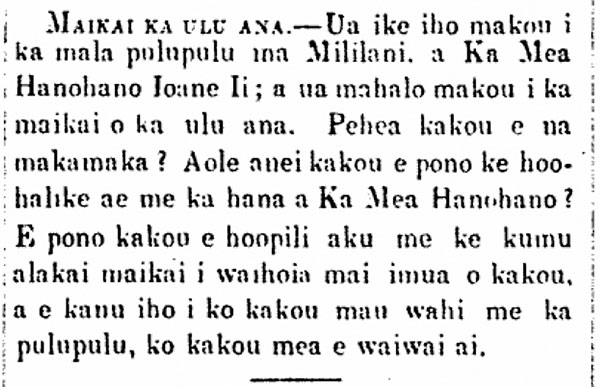Extinction Of Languages Is Natural
I took heat recently for writing that $28 million for a new Hawaiian Language College building in Hilo could be viewed as excessive.
One woman accused me of saying Hawaiian is just a “decorative” language (I didn’t). Scholar Puakea Nogelmeier claimed I’d written a “diatribe about wasting money on Hawaiian language” (never used the word “wasting”).

A snippet from 'Ka Nupepa Puka La,' a Hawaiian language newspaper still widely read in the early 1900s | Photo from Bob Jones
It’s estimated that 100 years from now 90 percent of the current 6,000 languages will be extinct. John McWhorter of the Manhattan Institute has written that “the extinctions cannot be stopped for the most part. Trying to teach people to speak their ancestral languages will almost never get far beyond the starting gate.”
Then there are the scholars who say that having two or more languages in a single community creates an apartheid system. Those point out that the Amish in America still speak German only because they live in isolation from modern life, which few of us would consider an ideal goal for indigenous groups.
Since 1500 A.D., the world has lost about 15 percent of the 7,000 languages we think were spoken then. A hundred years ago, Breton (a Celtic language in France) had a million speakers, but has faded out. Thirty years ago, about 85 percent of the Navajo children spoke Diné Bizaad as their first language. Now it’s about 25 percent.
A hundred years from now will we all speak English or Chinese or Spanish? Maybe as a principle language, but we see linguists all over starting to save texts and oral records in languages. I call that a good thing. We should never lose the thread of languages any more than we want to lose the thread of our evolution as human beings.
Those who thought I was dissing Hawaiian language study were dead wrong.
I was asking if $28 million of state money for a separate Hawaiian language building at UH-Hilo is more important than $38 million for a pharmacy college there.
The pharmacy college got scrapped.
The food I encountered recently on a stay at Kaiser Medical Center Moanalua certainly was no relative of what most of us have known as “hospital food.”
Now you call downstairs to “room service” and order whatever you want – whenever you want it – from a four-page menu, and room service waiters in jaunty berets bring it to you.
There’s Korean barbecue chicken, roast beef, any kind of pizza, omelets to order, saimin with char siu, egg and napa cabbage, somen salad, Chinese chicken salad with Mandarin orange slices, grilled cheeseburgers – the menu goes on and on. Room service from 7 a.m. to 6:30 p.m.
Kaiser hired veteran executive chef Steve Fontanilla to run the kitchen.
Hospital stays will never be the same.





